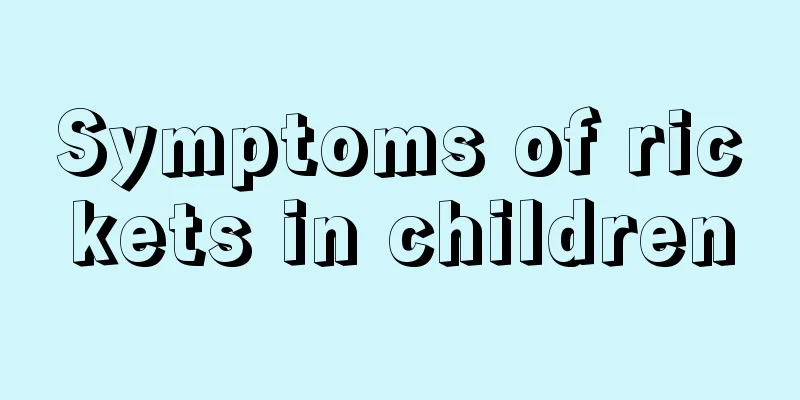Symptoms of rickets in children

|
Rickets is a disease with a very high incidence rate among children. This disease is mostly caused by a lack of vitamin D. The most obvious symptom is that children will have bow legs or X-shaped legs. In addition, it can also cause fractures and even deformities. Therefore, parents must pay great attention to rickets. Rickets has different stages of onset, and the symptoms vary at different stages. The following is a detailed introduction to the symptoms of rickets in children. 1. Early stage (early stage)It occurs in infants under 6 months old, especially infants under 3 months old. Most of them are manifestations of increased nervous excitability, such as irritability, restlessness, sweating, and baldness on the back of the head. There are usually no bone lesions at this stage, and the bone X-ray may be normal or the calcification band may be slightly blurred; serum 25-OH-D3 decreases, PTH increases, blood calcium decreases, blood phosphorus decreases, and alkaline phosphatase is normal or slightly elevated.
As the disease continues to worsen, typical bone changes such as PTH hyperfunction and abnormal calcium and phosphorus metabolism appear. Rickets in infants under 6 months old is mainly characterized by skull changes, soft edges of the anterior fontanelle, thin skull, and a "ping-pong ball" feeling when pressed lightly. After 6 months of age, there may be a ping-pong ball-like feeling around the sutures, but the central part of the frontal bone and parietal bone often gradually thickens. By 7 to 8 months of age, the head shape becomes "square" and the head circumference is larger than normal. The epiphyseal ends swell due to the accumulation of bone-like tissue, and a round protrusion can be felt at the junction of the ribs and costal cartilage along the rib direction. From top to bottom, it is like a string of beads, which is most obvious in the 7th to 10th ribs. It is called rickets beads. In severe cases, blunt round ring-shaped protrusions may also form on the wrists and ankles, which are called bracelets. In children around one year old, the sternum and adjacent cartilage can be seen protruding forward, forming a "pigeon chest" deformity; in children with severe rickets, a horizontal depression forms at the lower edge of the thorax, namely the costophrenic groove or Howe's groove. When the child sits or stands, the ligaments loosen and the spinal deformity may occur. Due to osteomalacia and muscle and joint relaxation, after the age of one, when the lower limbs begin to bear weight when standing and walking, the femur, tibia, and fibula may bend, forming severe knee valgum ("O" shape) or knee valgum ("X" shape) lower limb deformity. Severe hypophosphatemia may cause muscle sugar metabolism disorders, resulting in whole body muscle relaxation, decreased muscle tone and weakened muscle strength. During this period, except for a slightly lower serum calcium, changes in other blood biochemical indicators are more significant. X-rays show that the calcification band of long bones disappears, and the epiphyseal ends become brush-like and cup-shaped; the bone is sparse and the cortical bone becomes thinner; there may be diaphyseal curvature or greenstick fractures, and the fractures may have no clinical symptoms.
After treatment or sunlight exposure in any of the above stages, clinical symptoms and signs gradually alleviate or disappear. Blood calcium and phosphorus gradually return to normal, and alkaline phosphatase takes 1 to 2 months to return to normal levels. After 2 to 3 weeks of treatment, the bone X-ray changes improved, with irregular calcification lines appearing. Later, the calcification bands became denser and thicker, and gradually returned to normal. 4. Sequelae It is more common in children over 2 years old. Due to severe rickets in infancy and childhood, different degrees of bone deformities remain, such as O-shaped legs, X-shaped legs, pigeon chest, etc. There were no clinical symptoms, blood biochemistry was normal, and X-ray examination showed that the skeletal metaphyseal lesions had disappeared. |
<<: What does the physical examination for the baby to enter the kindergarten check?
>>: What to check for babies on their 42nd day
Recommend
How to reduce swelling after falling on the head
The younger the child, the more difficult it is t...
How to treat blisters on children's hands
If blisters appear on your child's hands, you...
Treatment and prevention of rickets in children?
Children are very susceptible to rickets, which i...
How to deal with sinusitis in children
If your child suffers from sinusitis, don't w...
How to use medication for dermatitis in children?
If the child does not pay attention to the hygien...
What should I do if my child suffers from recurrent constipation?
I believe everyone is familiar with the word cons...
How to cultivate children's nap habits
It is also a good way for children to maintain th...
What should I do if my baby has a stuffy nose before one month old?
Many mothers will encounter times when their babi...
What should children not eat if they have poor digestion and absorption?
Whether a child can grow up healthily depends not...
What’s going on if my baby has white spots on his throat and a fever?
When many babies are very young, they may often g...
Causes of vomiting and diarrhea in babies
Parents are very concerned about their baby's...
Can babies generally eat purple sweet potato porridge?
Most of our families now have one baby. The baby&...
Why do children bite their nails?
It is a common phenomenon for children to bite th...
What should I do if my child is bitten by an ant?
Ants are the most numerous creatures on Earth. Al...
Why does the child cry in the middle of the night?
We know that children can only grow up healthily ...









